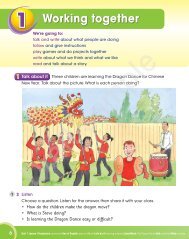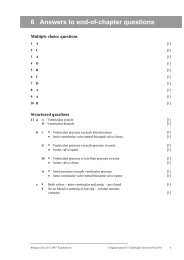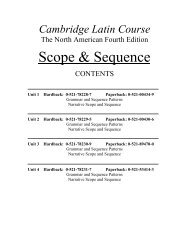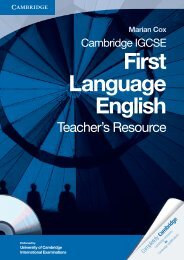Brad Philpot - Cambridge University Press
Brad Philpot - Cambridge University Press
Brad Philpot - Cambridge University Press
Create successful ePaper yourself
Turn your PDF publications into a flip-book with our unique Google optimized e-Paper software.
10 Use linking words and clauses<br />
You must indicate the relationships between your ideas as you present them to your<br />
reader. Look again at the list of linking words on page 65. Besides using linking words,<br />
also make good use of relative clauses, which are clauses like this one that use words<br />
such as which and that to link ideas together and make longer sentences. If you have a<br />
sentence starting with This, you can probably join it on to the sentence before.<br />
Instead of<br />
Shakespeare presented Banquo as the rightful and just leader of<br />
Scotland. This flattered King James. People at that time believed it was a<br />
religious sin to kill a king. Kings were chosen by the hand of God.<br />
use<br />
Instead, Shakespeare presented Banquo as the rightful and just leader of<br />
Scotland, which flattered King James. Furthermore, people at that time<br />
believed it was a sin to kill a king, as kings were chosen by God.<br />
Chapter 6 summary<br />
The focus in this chapter has been the context of composition, on<br />
gaining a greater understanding of literature by placing ourselves in<br />
the mind of the writer and learning about literary traditions. You began<br />
by looking closely at some examples of dystopian and historical fi ction.<br />
You have also seen the importance of researching the contexts in which<br />
literary texts are written and examined the philosophical and artistic<br />
movements of modernism and existentialism in relation to an extract<br />
from a novel by John Fowles. Understanding the zeitgeist of a writer<br />
opens new windows on a literary text and allows you to read more<br />
deeply between the lines. Finally, as preparation for the Paper 2 exam,<br />
you have learnt about the fi ve-paragraph essay structure and worked<br />
through ten tips to improve your writing style.<br />
Chapter 6 brings to a close Part 3 of the coursebook. By now, you<br />
will be familiar with the contexts of interpretation and composition,<br />
and know how they can shape meaning in the literary texts you are<br />
studying. In the next chapter you will be fi nding out more about the<br />
mechanics of fi ction. Before deciding how effective a certain writing<br />
style is for the purpose of a text, it is necessary to know more about the<br />
writing devices writers have at their disposal and how well they have<br />
chosen them in their texts.<br />
Chapter 6 The context of composition<br />
tip<br />
You may have noticed that the list is<br />
divided into two sets: Tips 1–5 start<br />
with Avoid … and Tips 6–10 with<br />
Use … Think of them as the dos<br />
and don’ts of writing. In pairs, check<br />
each other’s essays in response<br />
to an exam question. Have you<br />
included all the dos and avoided<br />
all the don’ts? Make a checklist for<br />
reviewing each other’s work.<br />
You could also try working in groups<br />
of ten, with each student assigned<br />
one of the tips to watch out for.<br />
Pass your essays around and as a<br />
group screen them for all ten ways<br />
to invigorate your writing style.<br />
Sample<br />
© <strong>Cambridge</strong> <strong>University</strong> <strong>Press</strong> 2011<br />
Further<br />
resources<br />
The Little, Brown Compact<br />
Handbook by Jane E. Aaron is an<br />
excellent, American guide on how to<br />
organise essays, invigorate writing<br />
style, use punctuation and cite<br />
sources. You will also fi nd it useful<br />
long after you have fi nished your IB<br />
Diploma course!<br />
159








